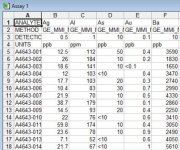Cariboo5
Hero Member
- Oct 27, 2011
- 766
- 1,262
- Primary Interest:
- All Treasure Hunting
I was reading up on this assay method and it sounds interesting for deep deposits. Has anyone sent in samples for this type of analysis and
do you feel it is accurate and cost effective? If not what type of assay method is most reliable?
The following explanation about Mobile Metal Iron is from their website:
"Mobile Metal Ions is a term used to describe ions which have moved in the weathering zone and that
are only weakly or loosely attached to surface soil particles. It has now been proven in a CAMIRO study
using Pb isotopes that these Mobile Metal Ions are transported from deeply-buried ore bodies to the
surface. Scientists from around the world have been studying this phenomenon for many years.
Convection, electrochemistry, diffusion, capillary rise and seismic pumping are some of the theories
which have been put forward. However, research and case studies over known ore-bodies have shown that
mobile metal ions accumulate in surface soils above mineralization, indicating that the metals are derived
from oxidation of the mineralization source. Capillary rise is thought to be a very important process in the
near surface environment which is responsible for maintenance of anomalies and dictates depth for
sampling. The hypothetical model suggests mobile ions are released from ore bodies, migrate vertically
and accumulate in surface soils.
As the ions reach the surface, they attach themselves weakly to the soil particles. These are the ions that
are measured by the MMI Technique to find mineralization at depths. The weakly attached ions are at
very low concentrations. Because the ions have recently arrived to the surface they provide a precise
‘signal’ on where the ore-bodies are."
do you feel it is accurate and cost effective? If not what type of assay method is most reliable?
The following explanation about Mobile Metal Iron is from their website:
"Mobile Metal Ions is a term used to describe ions which have moved in the weathering zone and that
are only weakly or loosely attached to surface soil particles. It has now been proven in a CAMIRO study
using Pb isotopes that these Mobile Metal Ions are transported from deeply-buried ore bodies to the
surface. Scientists from around the world have been studying this phenomenon for many years.
Convection, electrochemistry, diffusion, capillary rise and seismic pumping are some of the theories
which have been put forward. However, research and case studies over known ore-bodies have shown that
mobile metal ions accumulate in surface soils above mineralization, indicating that the metals are derived
from oxidation of the mineralization source. Capillary rise is thought to be a very important process in the
near surface environment which is responsible for maintenance of anomalies and dictates depth for
sampling. The hypothetical model suggests mobile ions are released from ore bodies, migrate vertically
and accumulate in surface soils.
As the ions reach the surface, they attach themselves weakly to the soil particles. These are the ions that
are measured by the MMI Technique to find mineralization at depths. The weakly attached ions are at
very low concentrations. Because the ions have recently arrived to the surface they provide a precise
‘signal’ on where the ore-bodies are."







